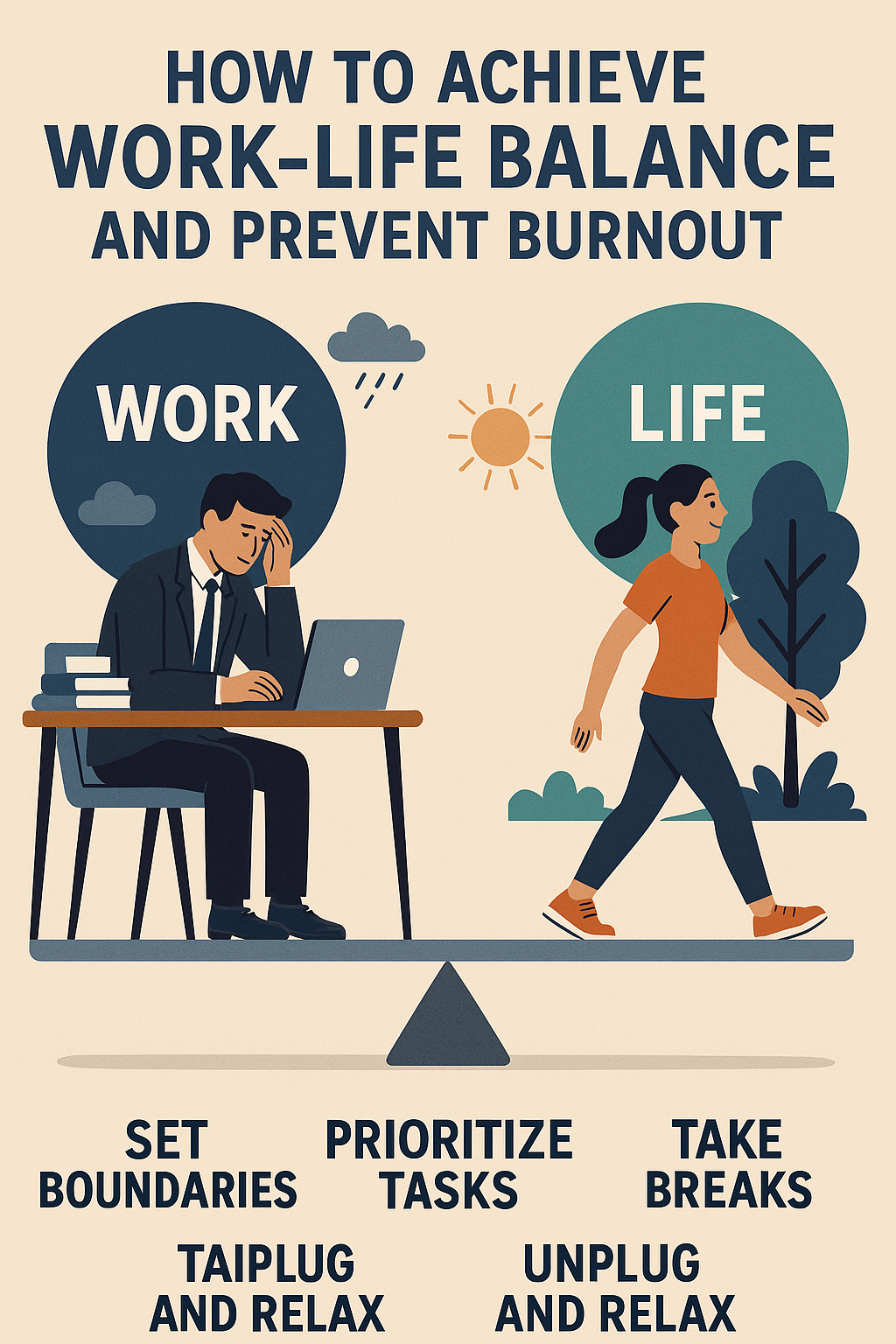In today’s fast-paced world, achieving a healthy work-life balance can be challenging. The constant pressure to perform at work, meet deadlines, and take care of personal responsibilities can lead to stress, exhaustion, and ultimately, burnout. Achieving work-life balance is essential for maintaining mental and physical health, as well as long-term productivity and happiness. In this article, we’ll explore practical strategies for achieving work-life balance and preventing burnout.
1. Set Clear Boundaries
One of the key components of work-life balance is setting boundaries between work and personal life. Without clear boundaries, it’s easy for work to spill over into your personal time, leading to stress and burnout. Setting boundaries allows you to be fully present in both your personal and professional life.
Tip: Establish specific work hours and stick to them. Avoid checking work emails or taking calls after hours. Make it clear to colleagues and family members when you are available for work-related tasks and when you’re off-duty.
2. Prioritize Self-Care
Taking care of your physical, mental, and emotional health is essential for preventing burnout. Self-care involves activities that rejuvenate and recharge you, allowing you to be more effective in all areas of your life. By prioritizing self-care, you ensure that you have the energy and resilience to handle both work and personal responsibilities.
Tip: Schedule regular time for self-care activities, such as exercise, meditation, hobbies, or relaxation. Make sure to get enough sleep and eat nutritious meals to keep your body and mind energized.
3. Manage Your Time Effectively
Effective time management is a crucial skill for maintaining work-life balance. When you manage your time well, you can allocate time for both work and personal activities, ensuring that you don’t overcommit to one area of your life. Time management helps reduce stress and gives you the ability to prioritize tasks efficiently.
Tip: Use tools like calendars, task managers, or time-blocking techniques to organize your day. Break tasks into smaller, manageable steps, and prioritize your most important responsibilities. Make sure to schedule time for relaxation and personal activities as well.
4. Learn to Say No
One of the reasons people experience burnout is because they take on too much. Learning to say no is essential for maintaining work-life balance. Saying no helps you avoid overcommitting and ensures that you can focus on what truly matters without spreading yourself too thin.
Tip: Be honest and assertive when setting boundaries. When you’re asked to take on extra work or participate in activities that don’t align with your priorities, politely decline. Remember, it’s okay to say no.
5. Delegate Tasks When Possible
Delegating tasks at work or at home helps reduce your workload and allows you to focus on your most important responsibilities. By delegating, you free up time for yourself and prevent feeling overwhelmed. It also fosters teamwork and cooperation, which can help reduce stress in both personal and professional environments.
Tip: Delegate tasks that others can handle and trust them to complete the work. At home, share household responsibilities with family members or consider outsourcing certain tasks (e.g., cleaning, grocery shopping) to create more time for yourself.
6. Take Breaks and Unplug
Taking regular breaks is essential for maintaining energy and focus throughout the day. It’s important to step away from work periodically to recharge and prevent mental fatigue. Additionally, unplugging from work and technology allows you to fully engage in personal activities and be present with loved ones.
Tip: Follow the Pomodoro Technique by taking short breaks every hour. Set boundaries for screen time outside of work and take time to engage in activities that don’t involve technology, such as reading, spending time outdoors, or socializing.
7. Set Realistic Expectations
Unrealistic expectations, whether from yourself or others, can lead to stress and burnout. It’s important to set achievable goals for yourself, both in your personal and professional life. Recognize that you cannot do everything perfectly, and it’s okay to make mistakes or ask for help.
Tip: Set SMART (Specific, Measurable, Achievable, Relevant, Time-bound) goals for both work and personal life. Regularly assess your goals to ensure they’re realistic and adjust them as necessary to avoid feeling overwhelmed.
8. Create a Supportive Environment
A supportive environment both at home and at work helps reduce stress and improve work-life balance. Surround yourself with people who encourage you, understand your needs, and offer support when necessary. Open communication with colleagues, family, and friends helps foster an environment where balance is possible.
Tip: Discuss your work-life balance goals with your supervisor, colleagues, and family members. Let them know your boundaries and ask for their support in maintaining a balance that works for you.
9. Take Time Off When Needed
Taking time off from work is essential for avoiding burnout and maintaining a healthy work-life balance. Whether it’s a vacation, a mental health day, or simply time to relax, taking breaks from work helps recharge your mind and body.
Tip: Use your paid time off (PTO) and take regular vacations or personal days. Make sure to truly disconnect from work during these breaks to give yourself the space to recharge.
10. Reevaluate Your Priorities Regularly
Work-life balance is not a one-time achievement it’s an ongoing process. Your priorities may shift as your career, family, and personal needs evolve. Regularly reevaluate your goals and commitments to ensure that you’re maintaining a balance that aligns with your current circumstances.
Tip: Set aside time every few months to assess your work-life balance. Adjust your schedule, boundaries, and commitments to align with your evolving priorities and avoid burnout.
